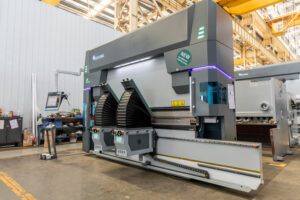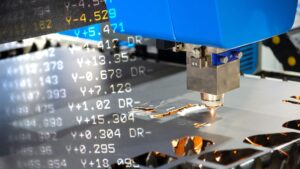Welcome to an in-depth journey through the world of hydraulic press brakes, a cornerstone in modern manufacturing and an indispensable tool for fabricating an array of metal products. In this comprehensive guide, we’ll dissect and analyze the role, functionality, advantages, applications, and costs associated with hydraulic press brakes.
What is a Hydraulic Press Brake?
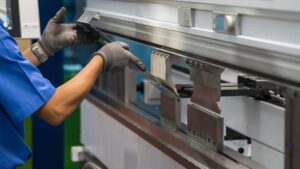
In its most fundamental sense, a hydraulic press brake is a specialized press brake type designed to bend sheet metal. It distinguishes itself from mechanical press brakes and electric press brakes by its use of hydraulic fluid to apply force to the press brake bending process.
This application of hydraulic force enables it to precisely form various shapes with different types of metals.
How Does a Hydraulic Press Brake Differ from Other Press Brakes?
While press brakes are universal in their aim to bend metal, the way they apply force significantly varies across different types.
In contrast to the mechanical press brake, which operates via a crank mechanism, and the electric press brake, that uses an electric motor, the hydraulic press brake utilizes hydraulic pumps to generate pressure. This hydraulic pressure then actuates the synchronized hydraulic cylinders to exert force on the material, allowing the machine to bend it to the desired angle. The use of hydraulics translates to a smoother operation, greater control, and overall bending length accuracy, even for larger, more complex parts.
What are the Key Components of a Hydraulic Press Brake?
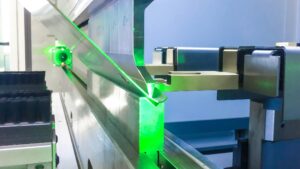
A hydraulic press brake consists of several essential parts, the interplay of which ensures the efficient execution of its function. These components include:
- Hydraulic cylinders: These generate the necessary pressure for the bending process.
- Machine operator controls: These allow the operator to adjust the bending angle and pressure, among other settings.
- Hydraulic fluid: This medium transmits the pressure within the hydraulic system.
- Die set: These tools determine the shape and radius of the bend.
How Does a Hydraulic Press Brake Work?
To get a comprehensive understanding of the hydraulic press brake, let’s dive deeper into the processes that power its operation.
What is the Basic Working Principle of a Hydraulic Press Brake?
The hydraulic press brake operates based on two principal elements: the force exerted by hydraulic fluid and the control accuracy of modern computer technology.
When the machine operator initiates the bending process, hydraulic pumps create pressure that drives the hydraulic fluid. This fluid then actuates the hydraulic cylinders, moving the ram vertically to apply force to the metal sheet positioned over a die.
The operator can control the ram’s speed, position, and force, leveraging CNC machines or computer controls to achieve highly accurate bends.
How Do Hydraulic Forces Enable Bending in a Press Brake?
Hydraulic forces, generated by hydraulic fluid pressure, enable the bending process in a press brake. The operator controls the hydraulic pressure, determining the force applied to the workpiece. This pressure causes the ram to travel down, pressing the sheet metal against the die to achieve the required bend angle.
What are the Stages of Operation of a Hydraulic Press Brake?
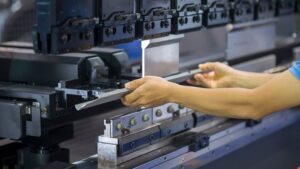
The operation of a hydraulic press brake is typically divided into three main stages: loading and aligning the material, executing the bend, and unloading the bent product.
How is Material Loaded and Aligned?
Initially, the machine operator loads the sheet metal onto the machine and aligns it with the die set. For modern machines, especially CNC hydraulic press brakes, this process is often aided by computer technology for enhanced precision and efficiency.
How is Bending Executed in a Hydraulic Press Brake?
Once the material is loaded and aligned, the operator initiates the bending process. The machine’s hydraulic system applies force, driving the ram to press the sheet metal onto the die set. The amount of force applied, along with the position and speed of the ram, is controlled precisely, ensuring the sheet metal bends to the desired angle.
What Happens in the Unloading Stage?
Following the completion of the bending process, the hydraulic press brake retracts the ram, relieving the force on the metal sheet. The operator can then unload the now bent metal piece from the machine.
What are the Advantages of a Hydraulic Press Brake?

The utilization of hydraulic press brakes offers several advantages over mechanical and electric variants.
Enhanced Precision
Hydraulic press brakes provide superior precision in bending operations. The machine operator controls allow for the accurate control of the ram’s motion, speed, and applied force, resulting in highly accurate bend angles.
Improved Safety
Hydraulic press brakes also increase safety for operators. The use of computer controls provides a greater degree of control, which reduces the risk of operational errors. Moreover, most press brakes are equipped with safety devices to prevent accidents.
Versatility
A standout advantage of hydraulic press brakes is their versatility. They can handle a variety of metals, different tonnages, and sheet thicknesses. They are also capable of forming various shapes, making them suitable for a broad range of industrial applications.
Where are Hydraulic Press Brakes Used?
Hydraulic press brakes find their usage in several sectors due to their flexibility, precision, and operational efficiency. Hydraulic press brakes are used widely to create precise bends in sheet metals, transforming them into various forms for use in different industries.
Automotive Industry
The automotive industry has been one of the biggest consumers of hydraulic press brakes. These machines are integral in the manufacturing and assembly process of automobiles due to their ability to shape and bend large pieces of sheet metal into various components.
- Bending and shaping chassis parts
- Forming automobile bodies
- Fabricating internal structures such as dashboard frames
- Production of smaller parts like brackets and supports
Aerospace Industry
The aerospace industry, known for its stringent standards for precision and quality, also heavily relies on hydraulic press brakes. The creation of various parts for aircraft requires exact bending and shaping, something that these machines can deliver consistently.
- Manufacturing of airplane wings and fuselage sections
- Fabrication of internal structural components
- Forming of landing gear parts
- Creation of smaller parts like brackets and mounts
Construction Industry
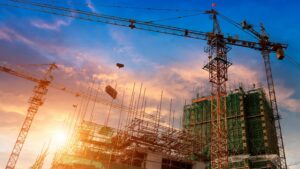
In the construction industry, hydraulic press brakes are utilized for creating structural elements, metal frames, and other parts required in building infrastructures.
- Production of steel frames and structural supports
- Fabrication of roofing and wall panels
- Creating HVAC components
- Shaping of gutter and drainage systems
Shipbuilding Industry
Hydraulic press brakes are also extensively used in the shipbuilding industry. Their ability to handle heavy and large pieces of metal sheet makes them ideal for forming the hull and other components of a ship.
- Bending and shaping large plates for ship hulls
- Creating internal structures and supports
- Fabricating parts for ship’s propulsion system
- Manufacturing of smaller parts like brackets and mounts
Manufacturing Sector
In the broader manufacturing sector, hydraulic press brakes have a myriad of uses. Any industry that needs to shape and bend metal for their products or parts will find these machines extremely valuable.
- Forming metal cabinets and enclosures
- Bending pipes and tubes
- Creating metal furniture frames
- Fabricating smaller components for various machines and equipment
How Much Does a Hydraulic Press Brake Cost?
A hydraulic press brake can cost anywhere from $5,000 to $200,000 and upwards. Understanding the cost of a hydraulic press brake involves considering various factors, including the size and complexity of the machine and the ongoing costs of operating it.
What Factors Influence the Cost of a Hydraulic Press Brake?
Several elements can affect the price of a hydraulic press brake, including its capacity (tonnage), bending length, CNC capabilities, brand, and whether it is new or used.
Size
The size of the machine is often directly proportional to the cost. Larger machines with higher tonnage capacities typically come with a higher price tag as they can handle thicker materials and larger workpieces.
- Entry-Level Hydraulic Press Brakes: These can cost anywhere from $5,000 to $20,000. These are typically smaller machines with less complexity and tonnage.
- Mid-Range Hydraulic Press Brakes: Machines in this category typically cost between $20,000 and $50,000. These machines often offer greater tonnage and length, as well as more advanced controls and features.
- High-End Hydraulic Press Brakes: Top-of-the-line machines can easily cost $50,000 to $200,000 or even more, depending on the specific model and its features. These machines are typically used for heavy-duty applications and feature advanced control systems, high tonnage, and long bed lengths.
Complexity of the Machine
The complexity of the hydraulic press brake also impacts its cost. Machines equipped with advanced features like CNC controls, a back gauge system, or a variety of press brake tooling options will be priced higher due to their increased functionality and precision.
What are the Ongoing Costs of Operating a Hydraulic Press Brake?
Beyond the upfront purchase cost, operating a hydraulic press brake involves ongoing expenses, including maintenance costs and energy consumption.
How Much Does Regular Maintenance Cost?
Regular maintenance of a hydraulic press brake is essential to ensure its optimal performance and longevity. These costs can include routine check-ups, replacement of worn-out parts, and hydraulic fluid refills.
What are the Typical Energy Consumption Costs?
While hydraulic press brakes are more energy-efficient than their mechanical counterparts, they still require a considerable amount of energy to operate. The energy consumption costs can vary depending on the machine’s size, usage frequency, and local electricity rates.
How to Maintain a Hydraulic Press Brake?
Proper maintenance is crucial to ensure the longevity and efficient operation of a hydraulic press brake.
What are the Key Aspects of Routine Maintenance for a Hydraulic Press Brake?
Routine maintenance for a hydraulic press brake generally involves tasks such as checking the hydraulic oil levels and quality, inspecting the machine for any signs of wear or damage, lubricating moving parts, and ensuring the cleanliness of the machine.
How Often Should Maintenance Be Conducted?
Maintenance frequency can depend on the usage of the machine. Generally, it’s advisable to conduct a full-scale maintenance check-up every six months. However, tasks like lubrication and cleanliness should be addressed daily.
What are the Best Practices for Long-Term Care of a Hydraulic Press Brake?
For the long-term care of a hydraulic press brake, regular maintenance checks, immediate addressing of any detected issues, and usage of the machine within its rated capacity are best practices. It’s also advisable to provide training to the machine operator to understand the correct operation and maintenance of the press brake.
While routine maintenance can be performed by trained operators, it’s recommended to hire a professional for comprehensive maintenance checks or when serious issues are detected. Professionals possess the knowledge and tools to diagnose and fix complex problems that may be beyond the understanding of a regular operator.
What are the main factors to consider when buying a hydraulic press brake?
Purchasing a hydraulic press brake is a significant investment. Understanding key considerations can help ensure you select the right machine for your specific needs. Here are some of the main factors to bear in mind:
Nature of Your Applications
Consider the specific tasks that your hydraulic press brake will be used for. Different models of press brakes are designed with varying capabilities and features to suit specific applications.
- Do you need to bend thick or thin materials?
- What is the typical bending length for your projects?
- What is the complexity of the bends you need to perform?
Machine Capacity
The machine’s capacity, defined by its tonnage and bending length, is an essential factor. This determines what size and thickness of materials the machine can handle and the kind of bending it can perform.
- What is the maximum tonnage the machine can apply?
- What is the maximum bending length the machine can accommodate?
Machine Features
Hydraulic press brakes come with a variety of features, which can enhance their performance and usability. These can include things like CNC controls for precision and programmability, back gauges for accurate positioning of the workpiece, and safety features.
- Does the machine come with CNC controls for precision and ease of use?
- Does it have a back gauge to assist with positioning the workpiece?
- What safety features does the machine have?
Budget

The cost of the machine is, of course, a key consideration. It’s important to weigh the cost of the machine against its capabilities and features. A higher price may be justified by increased productivity, improved accuracy, or reduced operating costs in the long term.
- How does the cost of the machine compare to its features and capabilities?
- Will the machine provide a return on investment through increased productivity or reduced operating costs?
Operating and Maintenance Costs
In addition to the purchase price, consider the ongoing costs of operating and maintaining the machine. These can include energy costs, maintenance costs, and the cost of replacement parts.
- What are the typical energy consumption costs?
- How often will the machine need maintenance, and what will this cost?
- How easy is it to obtain replacement parts, and what do they typically cost?
Vendor Support and Warranty
Finally, consider the level of support and warranty provided by the vendor. A good vendor will provide comprehensive after-sales support, including installation, training, and maintenance. A robust warranty can also provide peace of mind.
- What level of support does the vendor provide after the sale?
- Does the machine come with a warranty, and what does it cover?
ACCURL is a renowned hydraulic press brake manufacturer, recognized for its quality and innovative approach. Our CNC hydraulic press brakes are highly customizable, offering a broad range of sizes and configurations to meet diverse requirements.
Recognized among the Top 10 press brake manufacturers in China, ACCURL delivers power, productivity, and versatility with every machine. Our commitment to innovation and superior craftsmanship ensures reliable operation and flawless repeatability, making our hydraulic press brakes a top choice in the industry.
Conclusion
The hydraulic press brake, with its ability to deliver precision, versatility, and enhanced safety, has revolutionized numerous industries. It’s vital, however, to understand its workings, maintenance needs, and operational costs to fully harness its potential.
Whether used in the automotive, aerospace, or the wider manufacturing sector, these machines are invaluable tools, and an understanding of their features, costs, and proper maintenance can ensure their effective and efficient use for many years to come.


